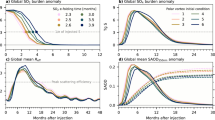Abstract
EXPLOSIVE eruptions, which inject large quantities of volcanic dust into the earth's upper atmosphere, are believed to be important factors in climatic change. Theoretical considerations suggest that the greatest climatic effect of a stratospheric dust veil would be at high latitudes during summer months, when solar radiation passes through the greatest depth of atmosphere and the surface is illuminated continously1. Furthermore, the residence time of volcanic dust is greatest at high latitudes, where it may remain in the upper atmosphere for a decade or more, depending on particle size and initial injection height2. Here we present evidence that the eruption of Mount Agung (8 °S, 115 °E) in March 1963, was responsible for a marked change in the climate of the North American High Arctic and that this change has had a significant impact on glacier mass balance in the region.
Similar content being viewed by others
References
Lamb, H. H. Phil Trans. R. Soc. Lond., A 266, 425 (1970).
Lamb, H. H. Climate: Present, Past & Future 1 (Methuen, London, 1972).
Miller, G. H., Bradley, R. S. & Andrews, J. T. Arct. Alp. Res. 7, 155 (1975).
Bradley, R. S. & England, J. Contrib. No. 31 184 (Univ. of Mass., Amherst. 1977).
Bradley, R. S. Nature 243, 398 (1973).
Koerner, R. M. Science 196, 15 (1977).
Müller, F. Proc. of Symp. on Arctic Heat Budget & Atmospheric Circulation (Rand Corp, Santa Monicsa, Calif., 1966).
Müller, F. Ice 23, 7 (1967); Ice 26, 9 (1968); Ice 33, 8 (1970).
Bradley, R. S. J. Glaciol. 14, 267 (1975).
Angell, J. K. & Korshover, J. Mon. Weath. Rev. 105, 375 (1977).
Yamomoto, R., Iwashima, T. & Hoshiai, M. J. Meteor. Soc., Japan 53, 482 (1975).
Dyer, A. J. & Hicks, B. B. Q. J. meteor. Soc. 94, 545 (1968).
Dyer, A. J. & Hicks, B. B. Nature 208, 131 (1965).
Hattersley-Smith, G. Geog. Annal. 42, 45 (1960).
Bradley, R. S. Arctic 26, 230 (1973).
Research supported by USNSF Climate Dynamics Program (Grant OCD75–00975).
Author information
Authors and Affiliations
Rights and permissions
About this article
Cite this article
BRADLEY, R., ENGLAND, J. Volcanic dust influence on glacier mass balance at high latitudes. Nature 271, 736–738 (1978). https://doi.org/10.1038/271736a0
Received:
Accepted:
Published:
Issue Date:
DOI: https://doi.org/10.1038/271736a0
- Springer Nature Limited
This article is cited by
-
The explosive volcanic eruption signal in northern hemisphere continental temperature records
Climatic Change (1988)
-
Neogene explosive volcanicity, temperature and glaciation
Nature (1979)





